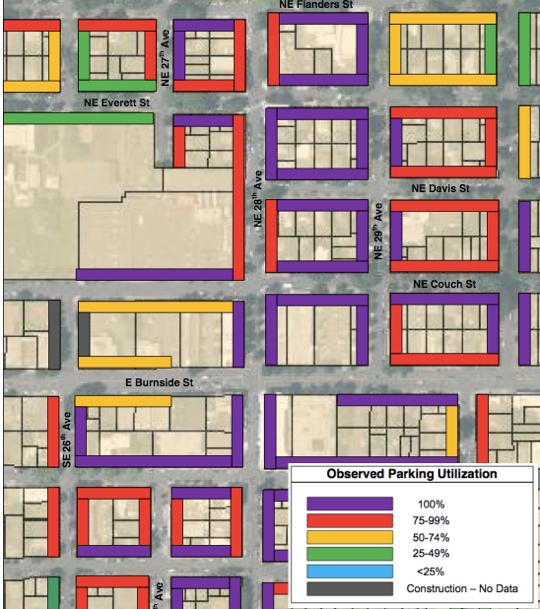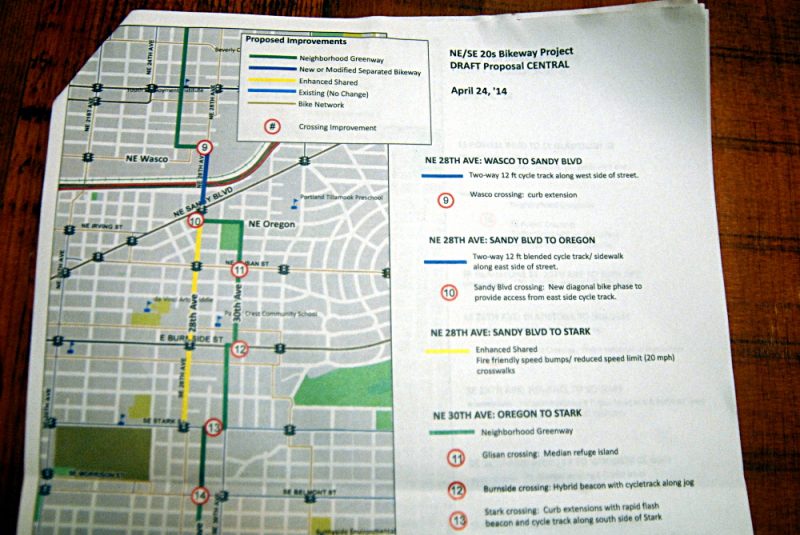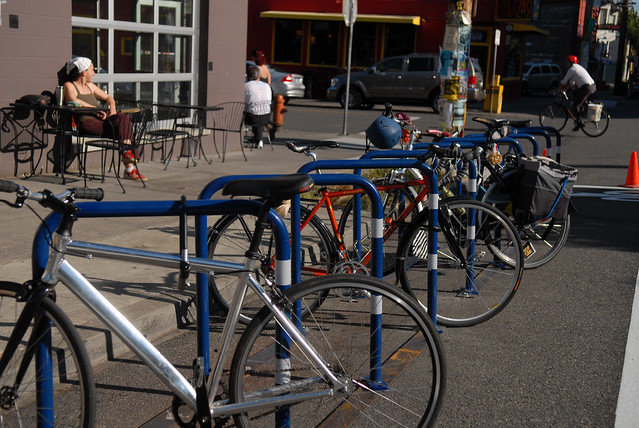
(Photo by J. Maus/BikePortland)
The Portland Bureau of Transportation on Thursday backed off from its proposal to replace about 100 auto parking spaces on 28th Avenue near Burnside with a buffered bike lane.
Available auto parking is “a very, very big deal” for neighborhood commercial districts like this one, project manager Rich Newlands told the 20s Bikeway Project stakeholder advisory committee at their meeting last night.
The city completed its first multi-street count of the neighborhood’s parking demand in time for Thursday’s meeting, which had been slated as the committee’s last. The results showed that many nearby blocks in the free-parking neighborhood were near capacity.
Below is PBOT’s “Parking Demand Map” showing that both sides of 28th through the commercial district are at “100% observed parking utilization”:

Instead of further straining the area’s free parking, Newlands said, the city is recommending an “interim solution” for the commercial district that takes three steps to improve biking through the area:
“What is the right amount of parking? We can agree or disagree. But people who actually have skin in the game are businesses. They will have a very loud voice at city council.”
— Rich Newlands, PBOT
- Improve 30th Avenue into a neighborhood greenway between NE Oregon and SE Stark streets, creating a lower-stress alternative to pedaling on 28th (but forcing north/south riders to head two blocks out of their way and back)
- Preserve a “line on the map” on 28th Avenue that would theoretically be improved for riders of all ages and abilities after the city has overhauled its parking policy.
- Use several traffic calming tactics on 28th Avenue between Oregon and Stark: fire-truck-friendly speed bumps, zebra crosswalks, a posted 20 mph speed limit and possibly green-backed “super sharrows.”
Unfortunately, Newlands and two city traffic engineers said, the first two strategies are likely to limit the possibilities for the third.
Because the city is spending much of its $2.4 million budget creating new traffic signals for the new side-street greenway (which will run parallel to the “official” bikeway at various points south of Interstate 84) it has less money to spend on traffic calming measures such as textured pavement. And because the city is still trying to preserve street space for a future bike facility on 28th, it’s recommending against new pedestrian bump-outs, pillars or other physical obstructions there.
Newlands said the city’s reversal was informed by what he described as a negative response to parking removal at a series of public open houses. (He interpreted some of the comments differently than we did.)

(Click to enlarge.)
Another factor: a petition, signed by almost every business on the strip, that urged the city to scrap its buffered bike lane plan through the district in order to keep auto parking (a plan that the Bicycle Transportation Alliance called a “step in the right direction”)
“What is the right amount of parking?” Newlands asked Thursday. “We can agree or disagree. But people who actually have skin in the game are businesses. They will have a very loud voice at city council.”
Sarah Holliday of Staccato Gelato at 232 NE 28th, who said she bikes to her storefront herself, said she’d started the process thinking differently.” I was willing to maybe give up parking on 28th; it didn’t seem so onerous to me,” she said. “But the more I learned about 30th Avenue, the more I didn’t see, if that is there, why removing parking on 28th is necessary.”
“We don’t have public transportation down 28th any more, and it’s kind of a hard neighborhood to get to,” Holliday went on. “People drive.”
BTA: ‘Couplet’ had been a compromise

Carl Larson, the Bicycle Transportation Alliance’s representative on the committee, said the “nine-mile neighborhood greenway” that the 20s Bikeway has largely become will be “a much-needed north-south route.”
But Larson was disappointed to see the so-called “couplet” proposal fail. Even that, he said, had never actually been a great bike facility.
“We saw the couplet as a good compromise, but what’s truly best for bicyclists and 28th Avenue businesses is a direct two-way connection on 28th,” Larson said. “It’s clear that the city has a lot of work to do and more tools to develop in order to make 28th the major city bikeway that it has been slated to become since the 70s.”
Larson, who seemed visibly depressed after Thursday’s meeting, had an interesting take on the possibility of adding sharrows to 28th.
In most other cities, he noted, sharrows mark shared lanes on busy streets. Portland’s decision to use them instead to mark low-stress neighborhood greenways had been “noble,” Larson said, a reflection of the city’s belief that it could “do better” than other cities by installing European-style separated bikeways along big commercial streets.
But when it comes to major commercial streets, Larson said, Portland has actually failed to do better than other cities, except in its choice to avoid dangerous door-zone bike lanes.
“This outcome here shows that we’re actually unable to get that protected facility,” Larson said. “We need to admit that we need to use sharrows, because people need and want access to businesses.”
Some argue less parking would help business
Though none of the bike-lane supporters on the committee vocally protested Newlands’ recommendation Thursday — some seemed to accept that the writing was on the wall — several questioned the premise that parking removal would hurt businesses.
Jeff Mandel of the Kerns Neighborhood Association cited instances from New York City and Santa Barbara in which projects that removed auto parking in favor of other street uses had increased revenue in business districts.
28th Avenue’s businesses, Mandel said, will never be able to grow unless their area can continue to reduce its dependence on auto parking.
“If you think parking is saturated today and you’re depending on people to come by car – well, guess what? [Your business] is not going to grow any more than it is today,” Mandel said. “The only way it’s going to grow is if you change that. … The fact is that a car takes up a fixed amount of space. And you can’t jam any more of them onto the street here.”
Garlynn Woodsong said the underlying auto parking problem isn’t that there’s too little of it, but that it’s being given away too cheaply.
“If my business model was to brew beer and give it away for free, and I ran out of beer, my solution would be to start charging,” Woodsong said. “This shows that this giving it away for free is not working.”
PBOT hopes for parking reforms

(Photo by M.Andersen/BikePortland)
Newlands seemed to agree. He predicted that for PBOT, reforming the city’s auto parking system will be “the next big issue that we take on.”
“We’re asking a lot of the public right of way,” Newlands said. “The future strongly suggests that parking will be at the bottom of the totem pole. Moving people, getting people to places, is going to be more important than storing cars.”
As we reported last fall, PBOT has received a state grant to examine the city’s auto parking policy. That project, now managed by city staffer Grant Morehead, is preparing to select its lead consultant, and the possibilities are already being discussed.
There are many other details about the 20s Bikeway beyond the 36-foot-wide central commercial section that has been subject to so much debate. The advisory committee decided Thursday that it’ll meet one last time to hammer them out. Look for a follow-up post here once we have digital copies of the current proposal.
The fate of the central section, however, seems to be determined until at least the end of summer 2015. At that point, Newlands said, the city will reasess.
Even then, of course, the fundamental challenge with the street will be the same.
“Goddamn it, why our forefathers didn’t give us 38 feet [of street width]?” Newlands joked, to frustrated laughter. “We can blame it on them.”
Correction 4/28: An earlier version of this post misstated the California city cited by Mandel as a case of successful parking removal.
— Jonathan proposed a different way to approach NE/SE 28th yesterday. Find that and all our coverage of the 20s Bikeway Project here.


